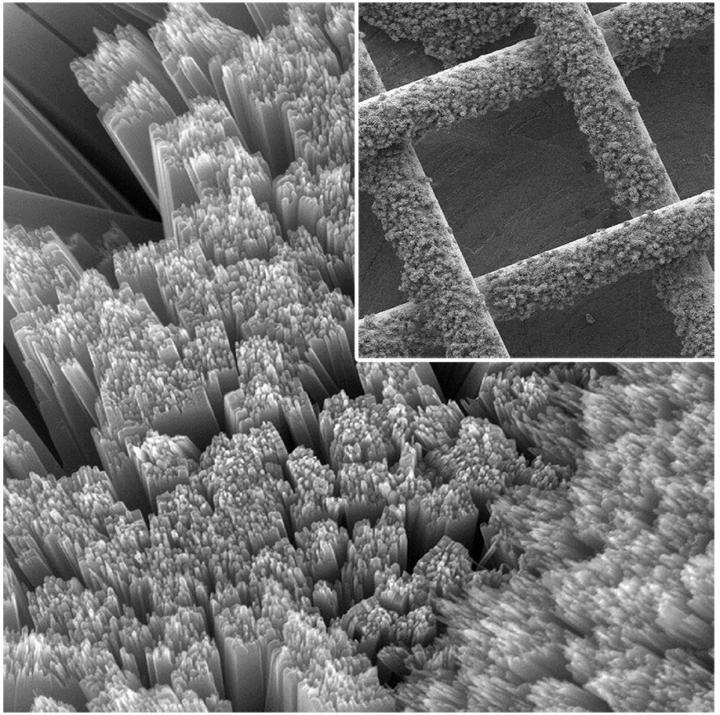A new device invented at The Ohio State University is the world's first hybrid solar generator and battery - it solves the problem of finicky solar power generation by having the storage built in.
The key is a mesh solar panel, which allows air to enter the battery, and a special process for transferring electrons between the solar panel and the battery electrode. Inside the device, light and oxygen enable different parts of the chemical reactions that charge the battery.
Yiying Wu, professor of chemistry and biochemistry at Ohio State, believes that their device brings down costs by 25 percent. It also helps solve a longstanding problem in solar energy efficiency, by eliminating the loss of electricity that normally occurs when electrons have to travel between a solar cell and an external battery. Typically, only 80 percent of electrons emerging from a solar cell make it into a battery.
In the new design, light is converted to electrons inside the battery, so nearly 100 percent of the electrons are saved.

Solar battery -- a combination solar cell and battery -- which recharges itself using air and light. The design required a solar panel which captured light, but admitted air to the battery. Here, scanning electron microscope images show the solution: nanometer-sized rods of titanium dioxide (larger image) which cover the surface of a piece of titanium gauze (inset). The holes in the gauze are approximately 200 micrometers across, allowing air to enter the battery while the rods gather light. Credit: Image courtesy of Yiying Wu, The Ohio State University.
"Basically, it's a breathing battery," Wu said. "It breathes in air when it discharges, and breathes out when it charges."
The design takes some cues from a battery previously developed by Wu and doctoral student Xiaodi Ren. They invented a high-efficiency air-powered battery that discharges by chemically reacting potassium with oxygen. The design won the $100,000 clean energy prize from the U.S. Department of Energy in 2014, and the researchers formed a technology spinoff called KAir Energy Systems, LLC to develop it.
For this new study, the researchers wanted to combine a solar panel with a battery similar to the KAir. The challenge was that solar cells are normally made of solid semiconductor panels, which would block air from entering the battery.
Doctoral student Mingzhe Yu designed a permeable mesh solar panel from titanium gauze, a flexible fabric upon which he grew vertical rods of titanium dioxide like blades of grass. Air passes freely through the gauze while the rods capture sunlight.
Normally, connecting a solar cell to a battery would require the use of four electrodes, the researchers explained. Their hybrid design uses only three.
The mesh solar panel forms the first electrode. Beneath, the researchers placed a thin sheet of porous carbon (the second electrode) and a lithium plate (the third electrode). Between the electrodes, they sandwiched layers of electrolyte to carry electrons back and forth.
Here's how the solar battery works: during charging, light hits the mesh solar panel and creates electrons. Inside the battery, electrons are involved in the chemical decomposition of lithium peroxide into lithium ions and oxygen. The oxygen is released into the air, and the lithium ions are stored in the battery as lithium metal after capturing the electrons.
When the battery discharges, it chemically consumes oxygen from the air to re-form the lithium peroxide.
An iodide additive in the electrolyte acts as a "shuttle" that carries electrons, and transports them between the battery electrode and the mesh solar panel. The use of the additive represents a distinct approach on improving the battery performance and efficiency, the team said.
The mesh belongs to a class of devices called dye-sensitized solar cells, because the researchers used a red dye to tune the wavelength of light it captures.
In tests, they charged and discharged the battery repeatedly, while doctoral student Lu Ma used X-ray photoelectron spectroscopy to analyze how well the electrode materials survived—an indication of battery life.
First they used a ruthenium compound as the red dye, but since the dye was consumed in the light capture, the battery ran out of dye after eight hours of charging and discharging—too short a lifetime. So they turned to a dark red semiconductor that wouldn't be consumed: hematite, or iron oxide—more commonly called rust.
Coating the mesh with rust enabled the battery to charge from sunlight while retaining its red color. Based on early tests, Wu and his team think that the solar battery's lifetime will be comparable to rechargeable batteries already on the market.
The U.S. Department of Energy funds this project, which will continue as the researchers explore ways to enhance the solar battery's performance with new materials.
Source: Ohio State University




Comments